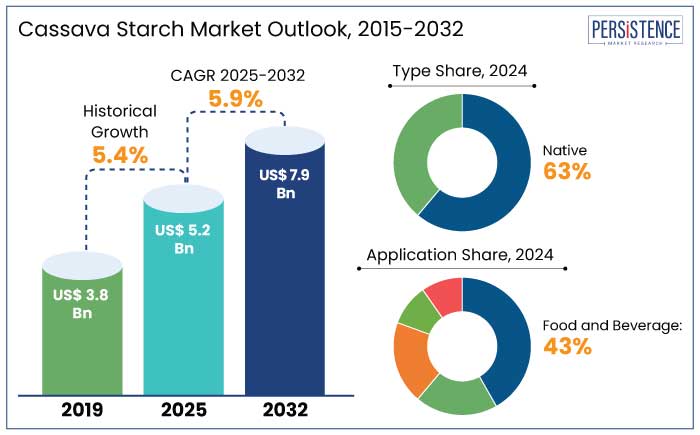ID: PMRREP16786| 191 Pages | 11 Jan 2025 | Format: PDF, Excel, PPT* | Food and Beverages

The global cassava starch market is predicted to reach a size of US$ 5.2 Bn by 2025. It is anticipated to experience a CAGR of 5.9% during the forecast period to reach a value of US$ 7.9 Bn by 2032. The food and beverage industry is estimated to account for 55% of the market’s revenue owing to the rising demand for clean-label products.
Demand for cassava starch in processed foods and convenience meals is expected to witness expansion, reflecting changing consumer lifestyles and urbanization. Innovations in cassava processing technologies are predicted to increase efficiency and decrease costs. Modified cassava starch is estimated to expand with applications in the paper, textile, and adhesive industries.

Key Highlights of the Industry
|
Market Attributes |
Key Insights |
|
Cassava Starch Market Size (2025E) |
US$ 5.2 Bn |
|
Projected Market Value (2032F) |
US$ 7.9 Bn |
|
Global Market Growth Rate (CAGR 2025 to 2032) |
5.9% |
|
Historical Market Growth Rate (CAGR 2019 to 2023) |
5.4% |
Asia Pacific holds a share of 58.1% in 2024. It is the most influential region in the cassava starch market with countries like Thailand, Vietnam, Indonesia, and China being the primary producers and exporters of cassava starch.
The food and beverages sector of the region is estimated to have high demand for cassava starch in noodles, snacks, and processed foods. It is also used industrial applications like paper manufacturing, adhesives, and textile sizing, thereby driving regional demand. Export markets in North America and Europe mainly rely on Asia Pacific for high-quality cassava starch.
The native cassava starch segment emerges as a leading type in the global cassava starch market with a share of 63% in 2024 owing to its natural, unmodified properties and broad applicability across various industries. Growth in the industry is driven by its versatility and increasing demand for clean-label ingredients.
Rising consumer preference for natural, minimally processed foods is one of the primary factors contributing to the growth of native cassava starch. As demand for gluten-free, allergen-free, and clean-label products increases, native starch aligns with this trend owing to its simple composition and lack of additives. Its neutral flavor and excellent binding properties make it an ideal choice for manufacturers looking to enhance the texture and shelf life of their products without adding artificial ingredients.
Native cassava starch is gaining traction in industrial applications, such as in the production of paper, textiles, and bio-based materials. The growing emphasis on sustainability has pushed companies to seek renewable and eco-friendly materials, and native cassava starch, being a naturally occurring substance, aligns well with these goals.
The food and beverage sector stands out as the leading application in the cassava starch market with a market share of 43% in 2024 due to increasing demand for processed, convenient, and health-conscious food products. There is increasing interest in functional foods that offer additional health benefits.
Cassava starch contains, resistant starch a form of fibre known for its digestive health benefits, which has made it popular in low-carb and weight management foods. The shift towards healthy eating patterns, including the consumption of plant-based and organic foods, is expected to boost cassava starch’s role in food formulations. Its role is especially crucial in applications like beverages, snacks, and sauces.
The rise in processed and convenience foods, further bolsters the use of cassava starch. Its ability to improve the texture, viscosity, and shelf stability of packaged food products make it a key ingredient in ready-to-eat meals, soups, and sauces.
The paper, textile, and adhesives lead the applications segment in the cassava starch market with a share of 35% in 2024 due to the growing demand for eco-friendly, sustainable, and cost-effective alternatives to traditional materials.
In the paper industry, cassava starch plays a critical role in the production of high-quality paper products. It is used as a coating and binding agent to improve the texture and finish of paper while enhancing its strength and printability.
In the textile industry, cassava starch is used primarily as a sizing agent in fabric processing to improve the strength and durability of fibres during manufacturing. Rising concerns over environmental impact and the demand for eco-friendly products has led textile companies to shift toward renewable and biodegradable materials.
Cassava starch is utilized in producing eco-friendly adhesives, especially for packaging and paper products. As companies move toward sustainable and biodegradable packaging solutions, the demand for cassava starch-based adhesives is on the rise.
The cassava starch market is predicted to be driven by the rising emphasis on eco-friendly products, fuelling demand for cassava starch in bioplastics and bio-packaging. Advancements in processing technologies are enhancing yield and quality, thereby decreasing production costs, and expanding the functional applications of cassava starch.
Increase in health awareness is driving the use of cassava starch in functional foods and beverages, especially owing to its resistant starch content that supports digestive health. Non-food industries, such as paper, textiles, and adhesives, are expected to contribute a notable share of the market, as manufacturers seek cost-effective and renewable raw materials.

The cassava starch market expanded at a CAGR of 5.4% during the historical period. The food and beverage sector played a pivotal role, contributed over 50% of the market revenue by 2023. This growth was attributed to increasing consumer preferences for gluten-free, allergen-free, and natural products, where cassava starch serves as an essential ingredient. Its application in processed foods, dairy alternatives, and clean-label products witnessed a surge due to lifestyle changes and urbanization.
Industrial applications, including paper, textile, and adhesives, contributed significantly to market growth. The demand for bio-based products and the rise of bioplastics further augmented cassava starch’s adoption as a sustainable raw material. Expansion during the period was partially hampered by competition from corn, potato, and wheat starch, especially in regions with well-established supply chains for alternative starches.
Rising Use in Textile Industry to Foster Expansion
Starches are used for different operations in the textile industry like warp sizing, cloth finishing, and printing. Cassava starch is one of the prominent ingredients utilized for the warp sizing application. The textile industry is witnessing significant growth, owing to its offering of customized solutions across the world. Textile applications including warp sizing and cloth finishing, are required to further provide viable textile solutions to consumers.
Textile manufacturers are also considering the use of an effective starch solution such as cassava starch, in varied textile operations. Furthermore, cassava starch is also utilized for cloth printing and placing a certain design on the smooth surface of fabric. Since the textile industry is continuously achieving growth in the global market, and demanding a viable starch solution, the demand for cassava starch is also estimated to increase.
Consumption of Functional Foods Escalating Demand
Functional foods contain the perfect nutritional balance of health beneficial properties. Consumers are opting for functional foods in order to maintain a healthy lifestyle. Functional foods are believed to create a positive impact on health and reduce the risk of certain diseases. Cassava starch contains sufficient amount of dietary fibre along with a low glycemic index.
Large percentage of the population is suffering from health issues like obesity and high blood sugar, due to which, consumers are adopting functional foods. High consumption of fat and sugar is responsible for obesity and related health problems. As cassava starch contains high fiber content, consumers are preferring it, driving the growth of the cassava starch market.
Competition from Other Starches to Hamper Growth
Competition from other starches, such as corn, potato, and wheat starch, is a significant restraining factor in the cassava starch market. Corn starch, for instance, dominates the global starch market, accounting for 60% of the total starch production worldwide. This is largely due to the extensive cultivation of corn in leading producing countries like the United States and China, coupled with its high starch yield and cost-effectiveness.
Potato starch, known for its superior thickening ability and clarity in solutions, is preferred in industries like paper, textiles, and certain food applications, despite its relatively higher cost.
The functional properties of alternative starches often align better with industrial requirements. For example, corn starch offers excellent gelatinization and thickening properties, while modified potato starch provides superior stability under extreme temperatures. This functional versatility challenges cassava starch, which may require modifications to match similar performance metrics.
Use in Snacks and Cereals Accelerating Growth
Cassava starch is among the vital ingredients used in the food and beverages industry. Bakery, dairy, snacks, and others are prime food products, where cassava starch is utilized. Food manufacturers are utilizing cassava starch for producing snacks and cereal products in order to enhance the quality of food products.
Cassava starch is used as a texturizing and water binding agent, and also helps to achieve the desired viscosity in snacks. The high viscosity, binding, and water holding properties of cassava starch make it suitable for use in making different snacks and cereal products. Since the demand for hot extruded snacks, pretzels, fried foods, and ready-to-eat cereals is growing, the cassava starch market is expected to benefit from this growth.
Rising Demand for Processed and Convenience Foods to Bolster Expansion
Modern lifestyles have resulted in an increasing preference for quick, ready-to-eat, and easy-to-prepare food options. Cassava starch, known for its versatility and neutral flavor profile, plays a vital role in this segment by serving as a thickener, stabilizer, and texture enhancer in several food products. Its high amylopectin content gives processed foods a desirable texture and shelf stability, meeting the quality expectations of consumers and manufacturers alike.
The global trend toward gluten-free and allergen-free diets has boosted the use of cassava starch as a substitute for wheat-based products. With the clean-label movement gaining momentum, cassava starch’s identity as a minimally processed, plant-based ingredient aligns well with the demand for transparency and natural food products.
Cassava starch has found applications in creating healthy food formulations, such as low-fat or low-calorie products. Its resistant starch component, which supports gut health and aids in weight management, further amplifies its appeal in health-conscious markets.
Companies in the cassava starch market are diversifying their product range by offering value-added products like modified starches, resistant starches, and bio-based products. They are focusing on creating tailor-made scratches that meet specific industrial requirements like varying viscosity or specific functional properties for different applications.
Businesses are adopting efficient and cost-effective production techniques to decrease production costs. They are streamlining their supply chain and securing better pricing for raw materials to enable manufacturers to decrease costs while maintaining competitive pricing.
Several companies are focusing on sourcing cassava sustainability, thereby ensuring minimal environmental impact. Cassava starch producers are adopting methods to recycle by-products from starch production process, like using cassava peel for animal feed or biogas production.
Recent Industry Developments
The market is anticipated to reach a size of US$ 7.9 Bn by 2032.
Yes, it is witnessing robust demand especially from food and beverage, textile, and pharmaceutical industries.
China, followed by Indonesia, U.S., and Malaysia are the top importers of cassava starch.
Tate & Lyle, Ingredion, Cargill, Incorporated are the prominent companies in the industry.
The market is anticipated to witness a CAGR of 5.9% through the assessment period.
|
Attributes |
Details |
|
Forecast Period |
2025 to 2032 |
|
Historical Data Available for |
2019 to 2023 |
|
Market Analysis |
US$ Billion for Value |
|
Key Regions Covered |
|
|
Key Market Segments Covered |
|
|
Key Companies Profiled in the Report |
|
|
Report Coverage |
|
|
Customization and Pricing |
Available upon request |
By Type
By Nature
By Application
By Region
Delivery Timelines
For more information on this report and its delivery timelines please get in touch with our sales team.
About Author